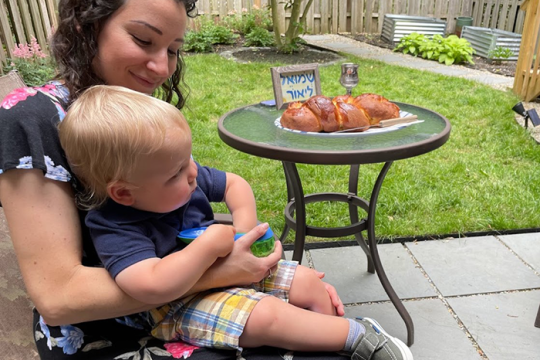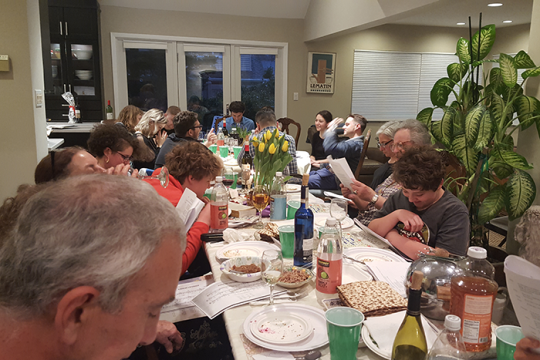As regular readers of this blog may have noticed through my comments on other people's posts, I've recently returned from a river cruise through Ukraine -- fortunately arriving home before the Georgian crisis erupted -- and want to share some thoughts in three general areas:
- Differences between Jewish and secular travel
- The changes that appear to have taken place in Ukraine since my prior trip in 2001
- Ukrainian roots for American Jews
Differences between Jewish and secular travel
Our trip was organized by Alumni Holidays International, and sponsoredby several university alumni associations. Although open seating andgeneral mingling prevailed aboard ship, our busses for shore excursionswere organized by school, with passengers from less represented schoolsassigned arbitrarily to the busses of the dominant institutions,University of Chicago (my alma mater), Cornell, Dartmouth, Tufts, andWilliam & Mary. Substantive content beyond that provided by verygood local guides came through two lectures each from three professors,covering history, identity, and language issues. The role of the Jewsis integral to talking about Ukrainian history, and was discussed bothby the guides and by the academics. My guess is that about 20% of theaudience was Jewish, with the percentage probably a little higher onthe University of Chicago bus.
My 2001 trip didn't focus on Ukraine, but it did start in Kiev, wherethis trip ended, and then went on to St. Petersburg and Moscow. Thattrip was organized as a leadership mission by ARZA World Union, theshort-lived combination of the Association of Reform Zionists ofAmerica and the World Union for Progressive Judaism - with theexpectation that we travelers would return to the U.S. as missionariesfor strengthening Progressive Judaism in the Former Soviet Union.
As might be expected, on the ARZA World Union trip, Jewish content wascentral, although we also got excellent coverage of key tourist sitesin Kiev like the Friendship Arch, the Founders monument, and the GreatGate - but no churches. (We did visit churches in Moscow and St.Petersburg.) The first stop in Kiev on the Alumni trip was Babi Yar,where the local guide was open not only about the Nazi round-up butalso about the Soviet effort to memorialize the tragedy withoutreference to Jewish victims. As the guide was concluding the visitwith an eloquent recitation of the Yevtushenko poem, I asked those of mytraveling companions who wished to join me in reciting Kaddish.
But beyond Babi Yar, the Jewish content in the professors' lecturesand guides' commentaries was essentially peripheral, as part ofdiscussing Ukraine's incredibly polyglot history. Nor were we shownany of the Jewish landmarks of Kiev: No Sholom Aleichem statue, noplaque marking Golda Meir's birthplace, no Brodsky synagogue.
The other contrast came in terms of creature comforts. Think dormrooms and dorm food for the alumni trip; think four and five-starhotels when you travel with the Reform movement. (For a trip I wasthinking of organizing, the travel counselor at ARZA's favored triparranger advised nothing less than four-star hotels - our clientelelikes its luxury.) My bottom line on this, as someone who travelsthree-star when I travel on my own, is that I'll go to France or Italyor the British Isles on a commercial tour, or an alumni tour, but ifI'm going to places rich in Jewish history and culture, I'll choose theJewish tour for its content, and accept the luxury as a bonus.
Changes in Ukraine since 2001
On our first night in Kiev in 2001, we came back to the hotel afterShabbat services at Congregation Hatikvah, and were having dinner inthe glassed-in rooftop restaurant when the night skies lit up withfireworks. It turned out we had arrived on the tenth anniversary ofUkrainian independence and the city was alive with excitement andpatriotic fervor....but it was still very much a Russian city. Threeyears after that visit, Kiev became the rallying point for the OrangeRevolution, a successful peaceful uprising with its roots in protestingelection fraud, but whose outcome placed in power the faction thatlooks towards Europe, ousting the faction that looks towards Russia.
We sensed a little more prosperity on this trip, but that may have beena matter of what we were shown each time - in 2001, a JointDistribution Committee soup kitchen, in 2008, the riverside McMansionsof the Ukrainian oligarchs. The city has grown about ten percent, tothree million, in these seven years, including major expansion on theother side of the river, and the years since the Orange Revolution haveseen a new emphasis on tourism. Only in Kiev, among the five Ukrainiancities we visited, did we find restaurants with English menus and withserving personnel who had a little of our language at their command.
As part of the move to identify more with Europe than with Russia, thepush is on to grow the use of the Ukrainian language in preference toRussian. Historically, Russian was more prevalent in the cities,Ukrainian in rural areas, especially in the western provinces, fartheraway from Russia. Both are Slavic languages, with Ukrainian moreheavily influenced by Polish and by the Russian dialect of Belarus. Both languages are written in Cyrillic, but there are subtledifferences between the Russian and Ukrainian alphabets. (As a sidenote, I taught myself the pronunciation of the Cyrillic letters byusing a siddur that included Hebrew transliterations.)
Whatever growth in affluence the city may have experienced, it has notrubbed off on the Progressive congregation. We visited Hatikvah's newhome - which Rabbi Duchovny explained is half the size at twice therent of the prior facility. Membership has been stable, whichapparently is also true of the two Orthodox congregations, oneLubavitch, one not. Kiev has an estimated one hundred thousand Jews,about the same number as before the Nazis and the Soviets - but in thepre-Nazi days that hundred thousand represented about twenty percent ofthe population; where today it's about three percent. The Progressivemovement has a great opportunity in Ukraine, as throughout the formerSoviet Union, but only if we North Americans subsidize itsdevelopment. One change that hasn't taken place in these seven yearsis the FSU budget of the World Union for Progressive Judaism, approximately $1.5 million compared to Chabad's $70 million. But that's a topic for another day.
Ukrainian roots for American Jews
One of the highlights of our 2001 trip to Kiev was a visit to theresidence of the U.S. ambassador, which was decorated with paintingsand sculpture by American artists of Ukrainian descent like LouiseNevelson and Andy Warhol. One thing I hadn't realized prior to seeingthat art was how many artists I had thought of as Russian were actuallyUkrainian.
This shouldn't have surprised me as much as it did. I had alwaysthought of my paternal grandparents as coming to the U.S. from Russia -but actually they were from the outskirts of Kiev. My mother was bornin what was then Poland, but is now Belarus. One tends to forget howfluid the borders were, as control of various territory shifted -- oneday under the control of the Russians, another day of the Poles or ofthe Austro-Hungarian empire.
In fact, a story is told of the Jewish couple who were given theirpreference when the boundary line was being drawn between Poland andRussia - did they want to be in Russia or Poland. When Shmuelimmediately opted for Poland, Rivke pointed out that the Poles werearguably more anti-Semitic than the Russians, True, Shmuel responded,but at least if we're on the Polish side of the line, we'll be sparedthe rigors of the Russian winter!
Looking at the borders as they are drawn today, and as they were inCzarist times, we have to remember that Jews could live only in theso-called Pale of Settlement, which included much of what is today'sUkraine. Whether our individual pictures of European Jewish life aredrawn from family memory or from Fiddler on the Roof or similarliterary sources, we have to remember that Anatevke/Kasrilevke and therest of Sholom Aleichem-land lay somewhere between Odessa and Kiev -subject to the Czar, but in Ukraine, not in Russia.
Virtually every couple among our Jewish compatriots on the tripincluded at least one spouse who talked about a parent or a grandparentwho had come to America from Ukraine. However, none mentioned addingan Everything is Illuminated excursion with a shtetl-shlepper in searchof their roots. On our 2005 WUPJ trip to Poland, many of our travelcompanions visited the towns their ancestors had left sixty to ahundred years before.
My wife hopes eventually to visitKamenetz-Podilsky, in western Ukraine, where her grandparents camefrom; our children adopted our grandson from Kharkov, in easternUkraine. But I have no family nostalgia, no sense of wanting to visitKobrin or Bershtivke, partly because my grandparents and older auntsand uncles never wanted to talk about "the old country" with itsapparently painful memories.
So why do so many of us travel to Warsaw, Cracow, Prague, Budapest,Moscow, St. Petersburg, and especially, I ask myself, why do I keepgoing back? It's more than the pull of the traveler's desire to seesomething new, or to see something old for the first time. I thinkmaybe it's to fit a few more pieces into the jigsaw puzzle of who weare and of the forces that shaped us - and to gain an appreciation forour grandparents (or parents, or great-grandparents) who had theforesight and the courage to pull up stakes , bringing with them toAmerica not much more than the treasure of Yiddishkeit.
But there'salso some pleasure in seeing the resurgence of Jewish life, slow thoughit be, in places where so many efforts were made to eradicate it. Mycongregation in Evanston is Beth Emet, the house of Truth - but mycongregation in Kiev is Hatikvah - the house of Hope.
Related Posts

Harnessing the Power of our Mothers Around the Seder Table

Melding Tradition and Innovation: Our Interfaith Toddler Naming Ceremony

